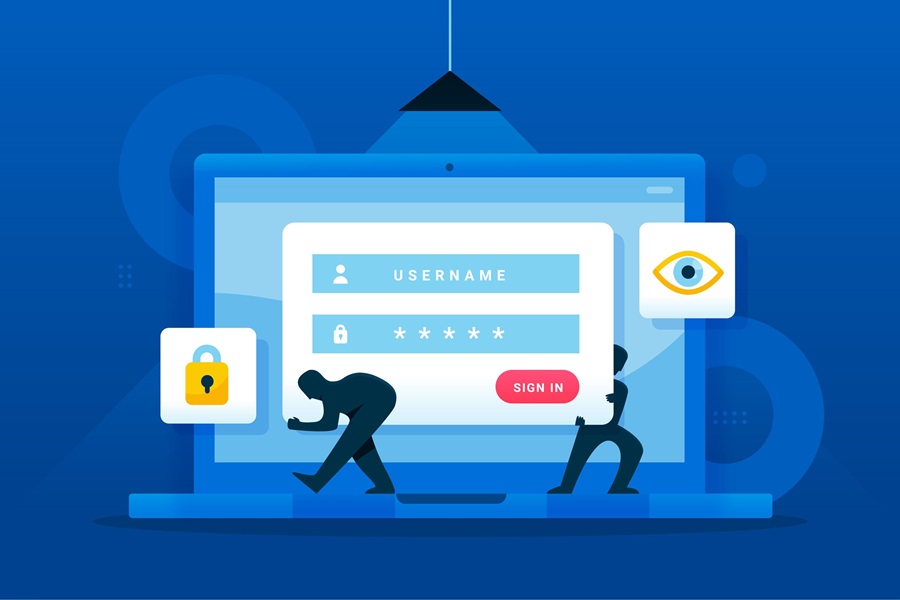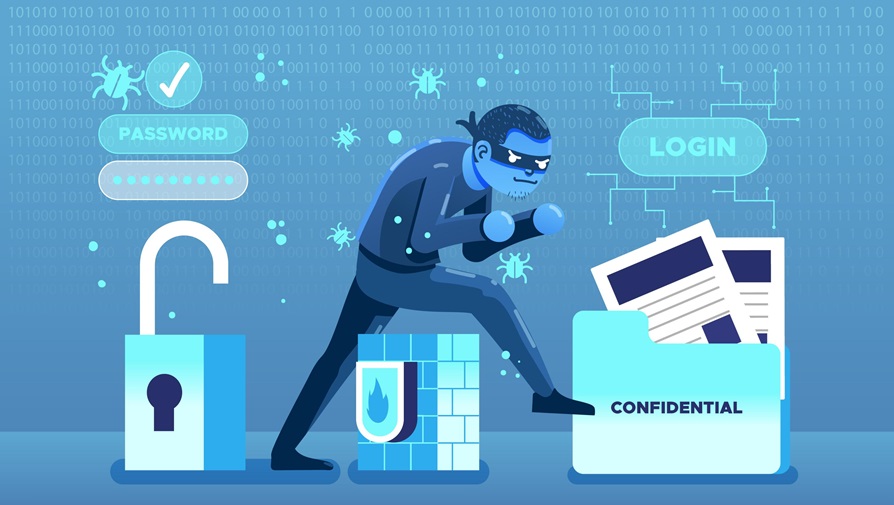Pass-the-hash attack is a type of cyberattack that has gained significant attention in lately digital environment. In a pass-the-hash (PtH) attack, hackers exploit hashed passwords or hashed user login credentials to gain unauthorized access to systems.
PtH attacks have become a serious concern, as they allow cyber attackers to gain unauthorized access to systems and sensitive or confidential information. It is crucial to understand the mechanics of PtH attacks and take appropriate preventive measures to protect against them.
For those unfamiliar with pass-the-hash attacks and hashed passwords, follow this guide to learn more about how pass-the-hash attacks work, including real-life examples and suggested measures to mitigate PhH attacks.
Understanding Pass-the-Hash (PtH) Attacks
A pass-the-hash (PtH) attack occurs when the cyber attacker steals the hashed user credential or password hash and uses it to deceive an authentication system into generating a new authenticated session on the same network.
Once the cyber attacker gains access to the entire attack surface or systems, they can perform various malicious activities, compromise sensitive data, or even escalate their privileges within the system.

But what does password hash mean exactly?
A password hash is the encrypted version of your password. When you set a system password, the operating system calculates a hash for the password using a mathematical formula. Instead of storing the actual password, the system stores the password hash.
Thus, in pass-the-hash, the cyber attacker doesn’t need to know the user’s actual password; instead, they just need the stored password hash to break through and gain unauthorized access to any user’s account. Hence, for a hacker, having access to a password hash is equivalent to having access to an actual user password.
How Pass-the-Hash Attacks Work
Pass-the-hash attacks exploit vulnerabilities in privileged accounts, enabling unauthorized access to critical systems and potentially compromising the entire network infrastructure.
Here is the step-by-step process that cyber attackers follow to perform pass-the-hash attacks.
- Initially, the hacker uses malware or social engineering techniques, like phishing, to gain access to a user’s account or device.
- Once hackers access the account, they use various specialized tools and techniques to scrape the active memory that helps derive data that leads them to password hashes.
- Once they successfully find password hashes, hackers pass the hash from one login to another, exploiting the single-sign-on technology, creating authenticated sessions, impersonating legitimate users, and creating a lateral movement across the network.
- With this lateral movement, hackers continue stealing hashes throughout the network in the hope of finding and exploiting hashes of user accounts with more business privileges within the business network.
- Accessing the password hash of a privileged user account and administrative access provides hackers access to much more confidential information and files and greater access to the network and its data.
- Once hackers find the data they’re looking for, they carry out malicious cyberattacks, such as identity theft, ransomware, or other types of data breaches.

Key Components of Pass-the-Hash Attacks
Pass-the-hash attacks involve capturing hashed login credentials instead of stealing plaintext passwords. To understand how to defend against PtH attacks, it is important to be familiar with their key components and how they are exploited. Here are the key components of pass-the-hash attacks:
- Password hashes: Cyber attackers steal or capture hashed versions of passwords instead of stealing plaintext passwords to gain unauthorized access to networks or systems. These hashes are fixed-length strings of characters stored in the systems that are unique to the original password.
- Credential dumping tools: Attacks also use tools like Mimikatz and others that can extract password hashes or plaintext passwords from the LSASS (Local Security Authority Subsystem Service) process to dump these credentials from the compromised systems’ memory.
- NTLM or Kerberos: Pass-the-hash attacks are commonly associated with Windows environments, such as NT LAN Manager (NTLM) or Kerberos authentication protocols. These protocols store hashed password versions that cyber attackers exploit to access systems.
- Pass-the-Ticket (PtT) and Pass-the-Key (PtK): Similar to the PtH attacks, cyber attackers also use Pass-the-Key (PtK) or Pass-the-Ticket (PtT) to exploit Kerberos tickets or key material to gain unauthorized access instead of password hashes.
- Lateral movement: After extracting hashed credentials, cyber attackers use these credentials to move later within the network. This allows them to access different systems or escalate privileges to potentially gain access to more sensitive information.
- Defense evasion techniques: Cyber attackers use several techniques to evade detection, like detecting logs, disabling security tools, or using cautious methods to move laterally within the network.
- Overpass-the-hash: In some cases, cybercriminals manipulate or replace the original password hash with a new password hash using the overpass-the-hash technique—ultimately changing the password of the compromised account.
Common Attack Vectors of Pass-the-Hash Attacks
Privileged accounts, such as those with domain administrator or admin privileges, become prime targets for PtH attacks. Here are some of the common attack vectors cyber attackers use to gain unauthorized access to systems and perform pass-the-hash attacks:
Weak authentication protocols
Weak default authentication protocols or a lack of multi-factor authentication (MFA) are often susceptible to pass-the-hash attacks. Cyber attackers target these protocols’ vulnerabilities to extract and misuse password hashes and ultimately compromise the particular account.
Legacy authentication mechanisms
Moreover, Cyber attackers also target legacy authentication mechanisms that lack robust authentication protocols. Since these protocols may not necessarily protect password hashes, it makes it much easier and more convenient for cyber attackers to extract them for unauthorized access.
Windows operating systems
Windows environments, especially the ones utilizing Active Directory, are vulnerable to pass-the-hash attacks. Because of the widespread adoption of Windows operating systems in enterprise environments and their weak authentication mechanisms, Windows OS is the common target vector of PtH attacks.
Insider threats
Malicious insiders with privileged access to networks and systems pose significant threats to businesses and act as common attack vectors for several cybersecurity attacks, including Pass-the-hash attacks. These insiders abuse their privileges to extract password hashes to either perform PtH attacks themselves or help other attacks to do so.
Insecure network communications channels
In cases when the network communication channel isn’t adequately protected or encrypted, it makes it easier for cyber attackers to eavesdrop on communications—identifying and extracting hashed passwords and performing PtH attacks.
Real-World Examples of Pass-the-Hash Attacks
Pass-the-hash attacks have severe impacts and consequences on businesses, from legal liabilities to compliance violations. Organizations can enhance their defense against attacks and protect sensitive information by understanding real-world examples and consequences. Here are some real-world examples of pass-the-hash attacks:
#1. The Diaxin Team Attack: “The Patient Data Breach”
The data extortion group known as The Diaxin Team stole more than 40 GB of data from Fitzgibbon Hospital in Marshall, MO, in 2022 using a pass-the-hash attack. The stolen data included patients sensitive patient information, such as names, social security numbers, dates of birth, and critical medical records. The hospital has confirmed that this attack impacted over 112,000 patients.

#2. Electrobas & Copel Attack: “The Utility Company Ransomware”
In February 2021, Brazilian electric utilities companies Centrais Electricas Brasileiras (Electrobas) and Companhia Paranaense de Energia (Copel) reported being targeted by ransomware attacks facilitated by the pass-the-hash attack.
Malicious actors compromised the Active Directory (AD), specifically the NTDS.dit file, extracting the password hashes. This allowed them to move laterally through the user’s permissions chain until they were able to extract hashes that had permissions enough to pull off ransomware attacks.
#3. Windows Themes Attack: “The Malicious Windows Theme Pack”
In September 2020, a security researcher uncovered that cybercriminals were distributing malicious Windows 10 theme packs that enable pass-the-hash attacks. These theme packs offer customization options for sounds, wallpapers, colors, and more.
Whenever any user clicks on the Windows theme pack, they are directed to a page or resource that requires access to their password hashes, enabling hackers to intercept the user’s login credentials.
These PtH attacks significantly impact organizations and businesses due to unauthorized access and compromised login credentials, leading to reputational damage, regulatory compliance violations, and loss of customer trust and competitive advantage within the industry. Hence, mitigating these attacks in the first place is paramount.
Best Practices to Prevent Pass-the-Hash Attacks
Preventing pass-the-hash attacks requires a multi-layered security approach that encompasses not only technical measures but also user awareness and education. By implementing these best practices, organizations can significantly reduce the risk of PtH attacks and ensure the integrity and security of their systems and data.
Best Practices for Prevent Pass-the-Hash Attacks for Users
To prevent pass-the-hash attacks, it is crucial to implement best practices and security measures. Here are some key recommendations for mitigating pass-the-hash attacks for users:
- Log out and restart your computer regularly: As soon as you finish your work, logging out of your device is one of the most crucial security practices to prevent others from accessing it. At the same time, restarting the device once in a while is essential to clearing stored hashes, which hackers can easily scrape during an attack.
- Don’t click on suspicious links: Pass-the-hash attacks often start with other types of phishing attacks. Hence, it’s crucial to be cautious about the links and email attachments you receive, especially when you receive them from unknown senders or email addresses. These links or attachments could be malware-induced, infecting or compromising your device in case you click or download them.
- Use a firewall: All major operating systems come with built-in basic firewalls to filter unauthorized network traffic. However, this is not sufficient for critical environments, and the best choice would be to implement a firewall.
- Rotate passwords regularly: Rotating passwords frequently can significantly prevent the risk of PtH attacks, as it minimizes the window or time duration of a valid password hash. A new password will require a new password hash, expiring or making the old password hash invalid.
- Enable a pop-up blocker: Pop-ups can often redirect you to unsafe or malicious websites, often induced with malware. These malware-induced websites assist PtH attacks. Hence, by enabling a pop-up blocker, you can limit the chances of accidentally clicking on malicious and dangerous links.
- Keep your operating system up-to-date: Updating your operating system is a good security practice that helps prevent security risks and vulnerabilities, as the latest OS upgrade comes with the latest security patches.
Best Practices for Prevent Pass-the-Hash Attacks for System Administrators
Preventing PtH attacks is crucial to maintaining the security of your system. Here are some best practices that system administrators should follow to mitigate the risk of PtH attacks.
- Disable Lan Management (LM) Hashes: Windows store passwords using Windows NT and LM hash. Since LM hash is weaker than Windows NT hash, according to Windows, and is vulnerable to brute force attacks, disabling them is crucial to avoid risks of PtH attacks.
- Enable Defender Windows Credential Guard: Windows Defender Credential Guard is a security tool provided in Windows 10 and above to mitigate PtH attacks.
- Avoid using Remote Desktop Protocol (RDP) for managing user workstations: Several RDP applications keep copies of your password hashes, expanding the surface area of PtH attacks. Hence, using a console tool instead that lets you connect to remote computers is much more secure than using RDP.
- Limit the Number of Accounts with Admin Rights: Malicious actors require administrative privileges to extract hashes from the Local Security Authority Subsystem Service (LSASS). Hence, it’s crucial to limit the number of admin accounts to make it harder for cybercriminals to conduct PtH attacks over your company network.
- User Microsoft Local Administrator Password Solution (LAPS): LAPS is a Windows security tool that, when enabled, ensures that the local admin account creates and uses a different complex password for every new computer it logs into. This limits the risks and chances of lateral movement for a cyber attacker—ensuring security against PtH attacks.
- Automate Password Changes for System Admins: Automating frequent password changes for admin credentials can make it significantly difficult for cyber attackers to pull off PtH attacks—limiting their time window to cause potential severe damage if they were able to extract the admin’s password hash.
Strategies for Effective Mitigation to Pass-the-Hash Attacks
To protect your organization from PtH attacks, it is crucial to implement effective mitigation strategies. Here are some strategies to consider:
#1. Incident response planning
Having an incident response plan is essential in the event of PtH attacks, which includes procedures for identifying the attack, detecting and preserving evidence, notifying the higher authorities and stakeholders, and restoring data and systems. Thus, having a designated and trained incident response team and a reliable data backup and recovery system in place will go a long way in minimizing the impact of PtH attacks and ensuring business security.

#2. Regular security assessments and audits
Regular security audits help businesses and organizations identify loopholes and vulnerabilities that make way for PtH attacks. These assessments and audits can include testing outdated software and firmware, weak passwords, and unsecured applications and systems.
#3. Training and Awareness
Security awareness training is an essential step for every business and organization to mitigate pass-the-hash attacks and other cybersecurity attacks. This training helps educate users and employees on preventive measures, password security practices, identifying suspicious activities, implementing strong password policies, and cybersecurity practices to effectively manage risks like PtH attacks.
#4. Privileged Access Management (PAM)
Privileged Access Management solutions help limit exposure to pass the hash attacks by controlling and monitoring access to privileged accounts. By implementing granular access controls, organizations can ensure that only authorized users have access to critical systems and information.
Securing Your Network: Preventing Pass-the-Hash Attacks
Pass-the-hash attacks can be difficult to detect or trace compared to other types of cyberattacks, such as phishing and ransomware. These attacks involve the use of a legitimate password hash to gain unauthorized access to a company network and potentially cause harm.
It’s important for organizations and security authorities to take PtH attacks seriously and invest time and effort into understanding their mechanics and potential consequences and implementing effective security measures to prevent and mitigate these attacks. Thus, implement the security practices mentioned above to protect against PtH attacks and strengthen your organization’s security.
More on Password Security
-
 EditorNarendra Mohan Mittal is a senior editor & writer at Geekflare. He is an experienced content manager with extensive experience in digital branding strategies.
EditorNarendra Mohan Mittal is a senior editor & writer at Geekflare. He is an experienced content manager with extensive experience in digital branding strategies.


